Managing Human Resources: Recruitment Challenges in Oil and Gas
VerifiedAdded on 2020/03/23
|9
|2464
|61
Case Study
AI Summary
This case study examines the recruitment challenges faced by the oil and gas industry, emphasizing the critical role of human resources in organizational success. The study identifies key challenges, including internal factors like firm size, recruitment policies, and organizational image, as well as external factors such as demographic trends, labor market conditions, and labor laws. It highlights the industry's need to attract and retain skilled professionals, given the anticipated growth and attrition rates. The case study proposes various recruitment strategies to address these challenges, including utilizing employment agencies, strategic advertising, branding through word-of-mouth, and employee referrals. The conclusion underscores the importance of systematic HR processes, particularly in attracting, screening, and selecting the right candidates to ensure the long-term success of the organization. This case study is designed to help students understand the complexities of human resource management in the oil and gas sector.
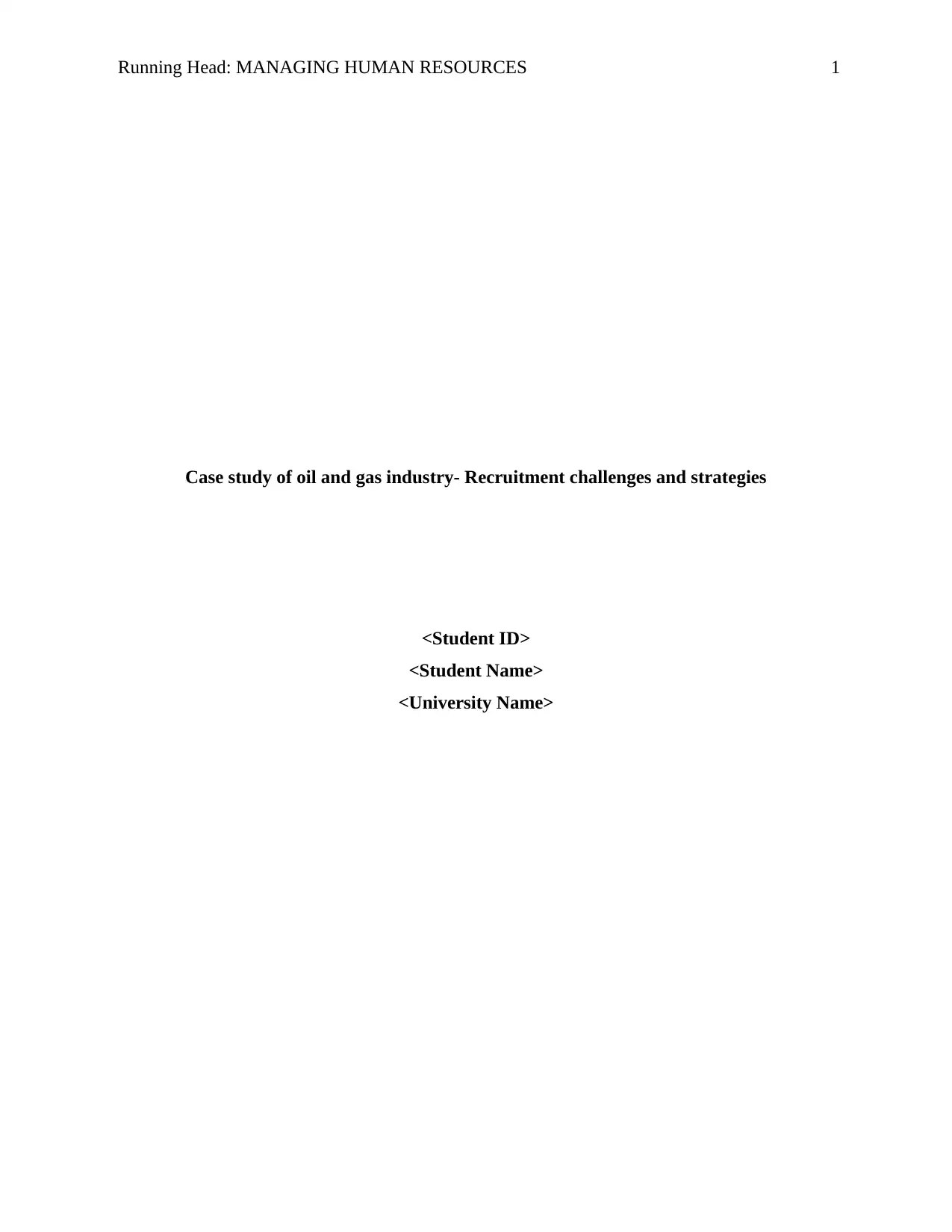
Running Head: MANAGING HUMAN RESOURCES 1
Case study of oil and gas industry- Recruitment challenges and strategies
<Student ID>
<Student Name>
<University Name>
Case study of oil and gas industry- Recruitment challenges and strategies
<Student ID>
<Student Name>
<University Name>
Secure Best Marks with AI Grader
Need help grading? Try our AI Grader for instant feedback on your assignments.
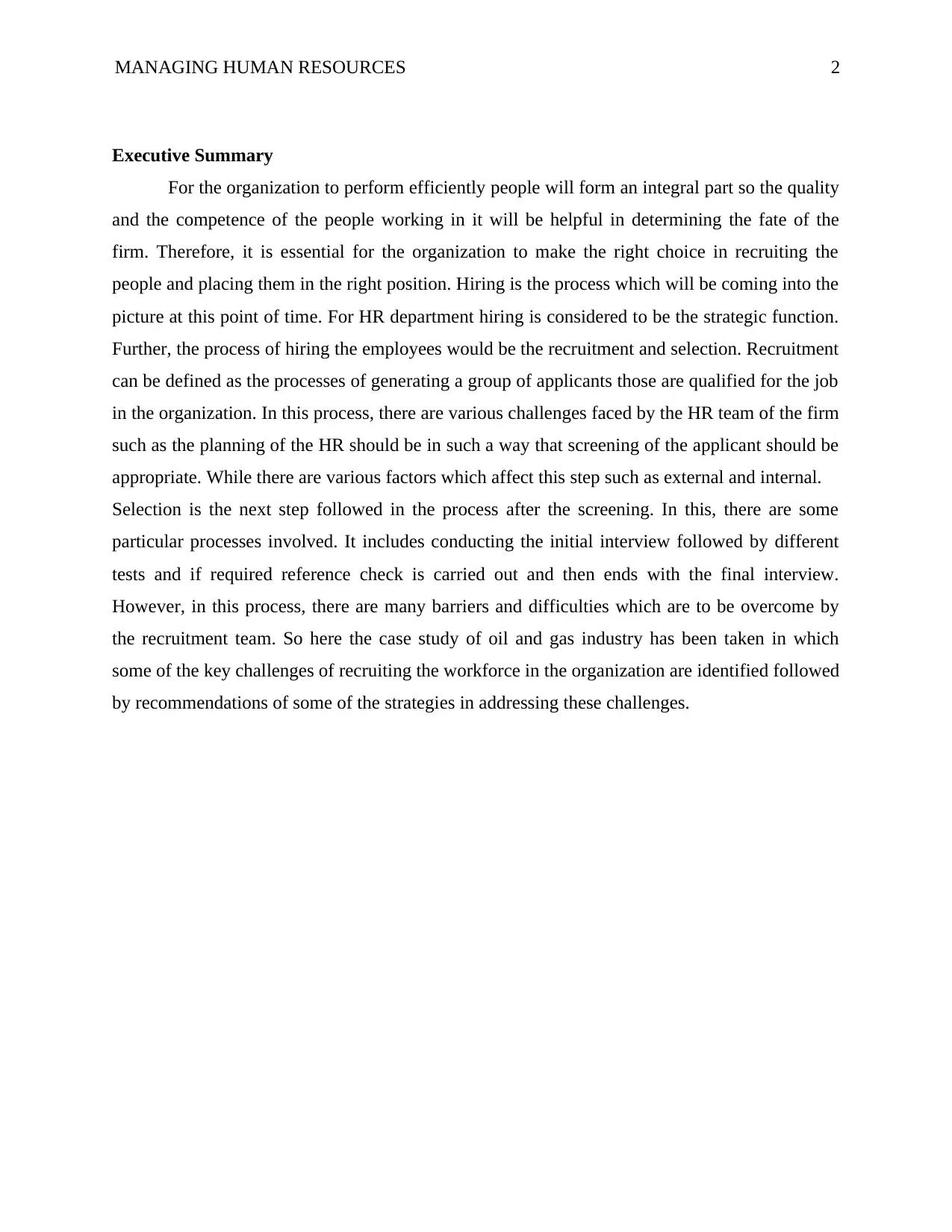
MANAGING HUMAN RESOURCES 2
Executive Summary
For the organization to perform efficiently people will form an integral part so the quality
and the competence of the people working in it will be helpful in determining the fate of the
firm. Therefore, it is essential for the organization to make the right choice in recruiting the
people and placing them in the right position. Hiring is the process which will be coming into the
picture at this point of time. For HR department hiring is considered to be the strategic function.
Further, the process of hiring the employees would be the recruitment and selection. Recruitment
can be defined as the processes of generating a group of applicants those are qualified for the job
in the organization. In this process, there are various challenges faced by the HR team of the firm
such as the planning of the HR should be in such a way that screening of the applicant should be
appropriate. While there are various factors which affect this step such as external and internal.
Selection is the next step followed in the process after the screening. In this, there are some
particular processes involved. It includes conducting the initial interview followed by different
tests and if required reference check is carried out and then ends with the final interview.
However, in this process, there are many barriers and difficulties which are to be overcome by
the recruitment team. So here the case study of oil and gas industry has been taken in which
some of the key challenges of recruiting the workforce in the organization are identified followed
by recommendations of some of the strategies in addressing these challenges.
Executive Summary
For the organization to perform efficiently people will form an integral part so the quality
and the competence of the people working in it will be helpful in determining the fate of the
firm. Therefore, it is essential for the organization to make the right choice in recruiting the
people and placing them in the right position. Hiring is the process which will be coming into the
picture at this point of time. For HR department hiring is considered to be the strategic function.
Further, the process of hiring the employees would be the recruitment and selection. Recruitment
can be defined as the processes of generating a group of applicants those are qualified for the job
in the organization. In this process, there are various challenges faced by the HR team of the firm
such as the planning of the HR should be in such a way that screening of the applicant should be
appropriate. While there are various factors which affect this step such as external and internal.
Selection is the next step followed in the process after the screening. In this, there are some
particular processes involved. It includes conducting the initial interview followed by different
tests and if required reference check is carried out and then ends with the final interview.
However, in this process, there are many barriers and difficulties which are to be overcome by
the recruitment team. So here the case study of oil and gas industry has been taken in which
some of the key challenges of recruiting the workforce in the organization are identified followed
by recommendations of some of the strategies in addressing these challenges.
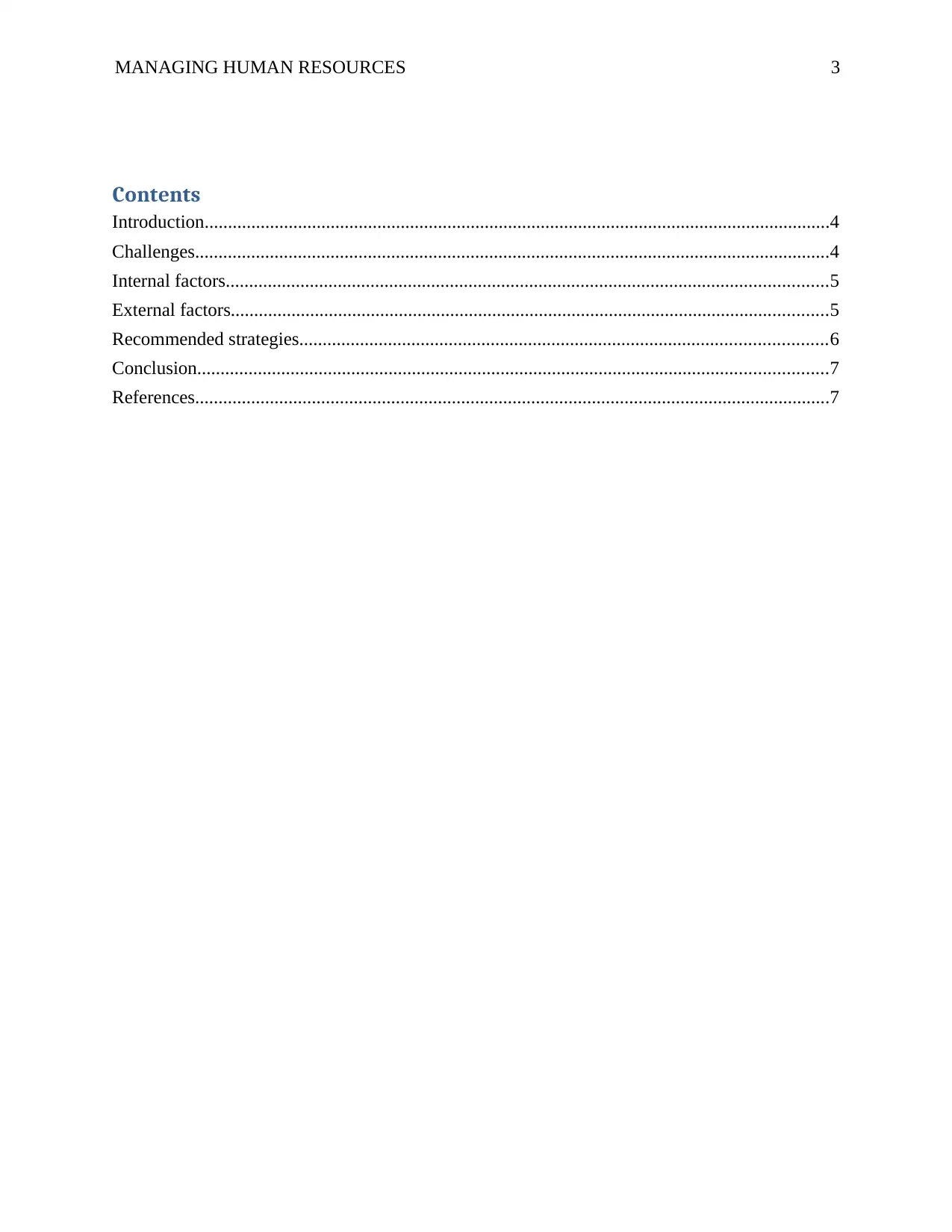
MANAGING HUMAN RESOURCES 3
Contents
Introduction......................................................................................................................................4
Challenges........................................................................................................................................4
Internal factors.................................................................................................................................5
External factors................................................................................................................................5
Recommended strategies.................................................................................................................6
Conclusion.......................................................................................................................................7
References........................................................................................................................................7
Contents
Introduction......................................................................................................................................4
Challenges........................................................................................................................................4
Internal factors.................................................................................................................................5
External factors................................................................................................................................5
Recommended strategies.................................................................................................................6
Conclusion.......................................................................................................................................7
References........................................................................................................................................7
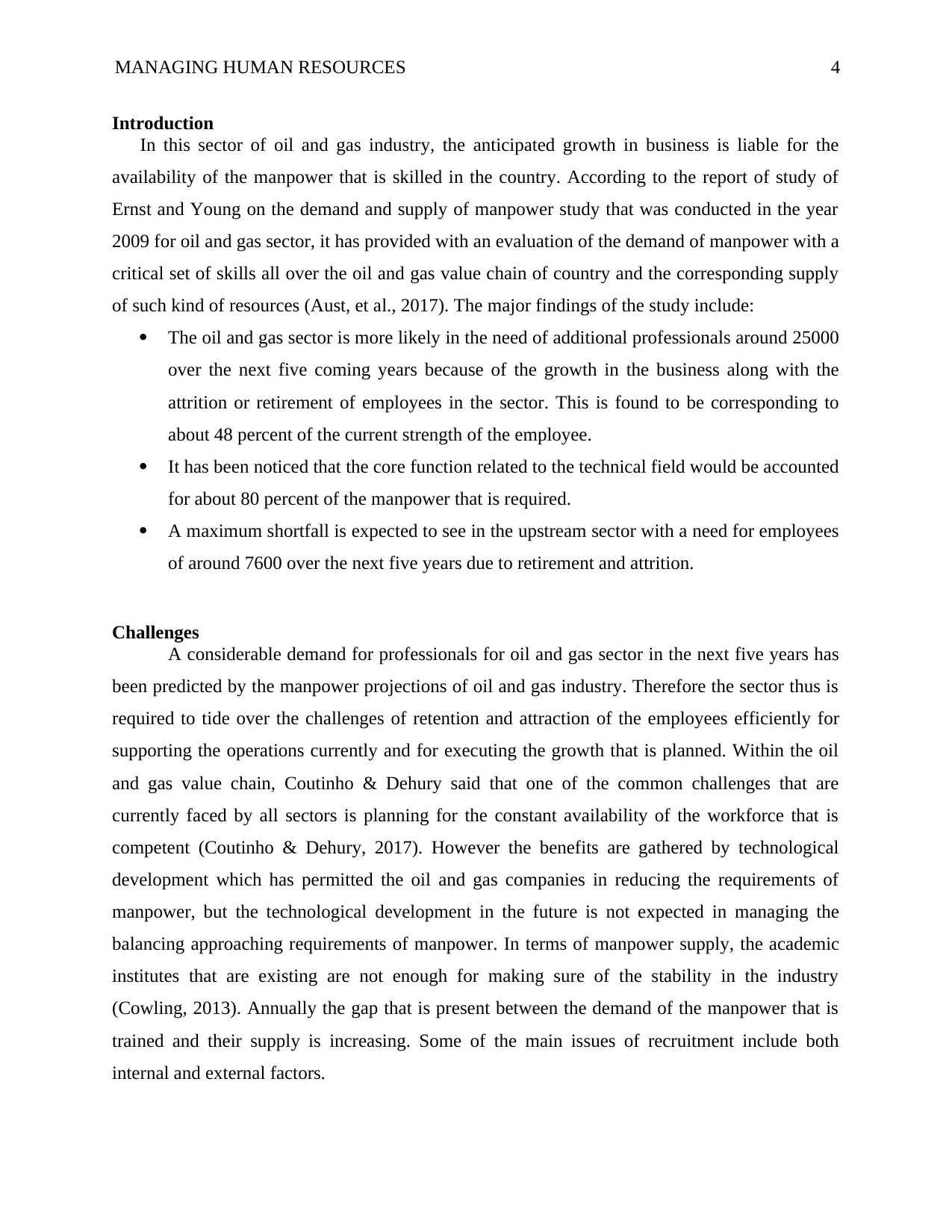
MANAGING HUMAN RESOURCES 4
Introduction
In this sector of oil and gas industry, the anticipated growth in business is liable for the
availability of the manpower that is skilled in the country. According to the report of study of
Ernst and Young on the demand and supply of manpower study that was conducted in the year
2009 for oil and gas sector, it has provided with an evaluation of the demand of manpower with a
critical set of skills all over the oil and gas value chain of country and the corresponding supply
of such kind of resources (Aust, et al., 2017). The major findings of the study include:
The oil and gas sector is more likely in the need of additional professionals around 25000
over the next five coming years because of the growth in the business along with the
attrition or retirement of employees in the sector. This is found to be corresponding to
about 48 percent of the current strength of the employee.
It has been noticed that the core function related to the technical field would be accounted
for about 80 percent of the manpower that is required.
A maximum shortfall is expected to see in the upstream sector with a need for employees
of around 7600 over the next five years due to retirement and attrition.
Challenges
A considerable demand for professionals for oil and gas sector in the next five years has
been predicted by the manpower projections of oil and gas industry. Therefore the sector thus is
required to tide over the challenges of retention and attraction of the employees efficiently for
supporting the operations currently and for executing the growth that is planned. Within the oil
and gas value chain, Coutinho & Dehury said that one of the common challenges that are
currently faced by all sectors is planning for the constant availability of the workforce that is
competent (Coutinho & Dehury, 2017). However the benefits are gathered by technological
development which has permitted the oil and gas companies in reducing the requirements of
manpower, but the technological development in the future is not expected in managing the
balancing approaching requirements of manpower. In terms of manpower supply, the academic
institutes that are existing are not enough for making sure of the stability in the industry
(Cowling, 2013). Annually the gap that is present between the demand of the manpower that is
trained and their supply is increasing. Some of the main issues of recruitment include both
internal and external factors.
Introduction
In this sector of oil and gas industry, the anticipated growth in business is liable for the
availability of the manpower that is skilled in the country. According to the report of study of
Ernst and Young on the demand and supply of manpower study that was conducted in the year
2009 for oil and gas sector, it has provided with an evaluation of the demand of manpower with a
critical set of skills all over the oil and gas value chain of country and the corresponding supply
of such kind of resources (Aust, et al., 2017). The major findings of the study include:
The oil and gas sector is more likely in the need of additional professionals around 25000
over the next five coming years because of the growth in the business along with the
attrition or retirement of employees in the sector. This is found to be corresponding to
about 48 percent of the current strength of the employee.
It has been noticed that the core function related to the technical field would be accounted
for about 80 percent of the manpower that is required.
A maximum shortfall is expected to see in the upstream sector with a need for employees
of around 7600 over the next five years due to retirement and attrition.
Challenges
A considerable demand for professionals for oil and gas sector in the next five years has
been predicted by the manpower projections of oil and gas industry. Therefore the sector thus is
required to tide over the challenges of retention and attraction of the employees efficiently for
supporting the operations currently and for executing the growth that is planned. Within the oil
and gas value chain, Coutinho & Dehury said that one of the common challenges that are
currently faced by all sectors is planning for the constant availability of the workforce that is
competent (Coutinho & Dehury, 2017). However the benefits are gathered by technological
development which has permitted the oil and gas companies in reducing the requirements of
manpower, but the technological development in the future is not expected in managing the
balancing approaching requirements of manpower. In terms of manpower supply, the academic
institutes that are existing are not enough for making sure of the stability in the industry
(Cowling, 2013). Annually the gap that is present between the demand of the manpower that is
trained and their supply is increasing. Some of the main issues of recruitment include both
internal and external factors.
Secure Best Marks with AI Grader
Need help grading? Try our AI Grader for instant feedback on your assignments.
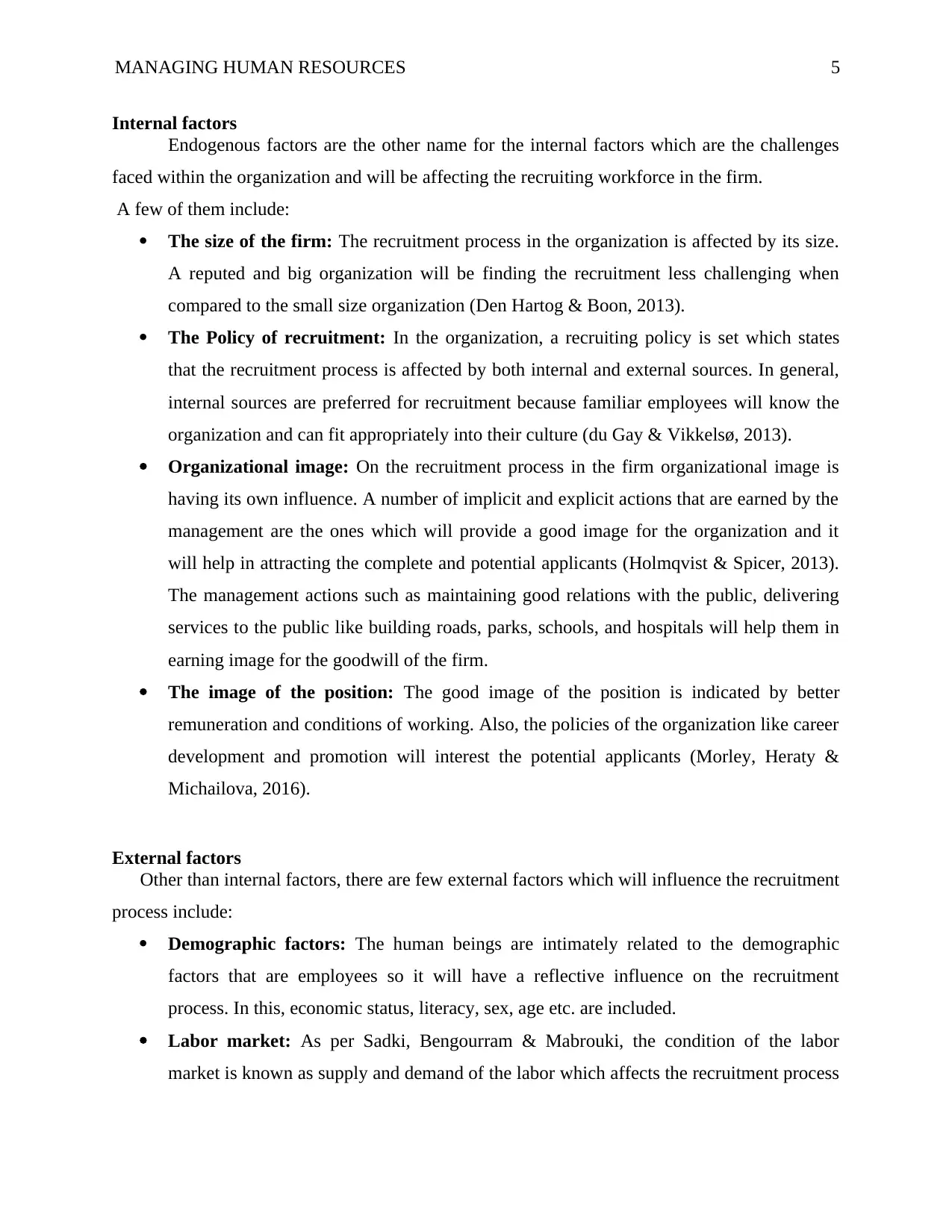
MANAGING HUMAN RESOURCES 5
Internal factors
Endogenous factors are the other name for the internal factors which are the challenges
faced within the organization and will be affecting the recruiting workforce in the firm.
A few of them include:
The size of the firm: The recruitment process in the organization is affected by its size.
A reputed and big organization will be finding the recruitment less challenging when
compared to the small size organization (Den Hartog & Boon, 2013).
The Policy of recruitment: In the organization, a recruiting policy is set which states
that the recruitment process is affected by both internal and external sources. In general,
internal sources are preferred for recruitment because familiar employees will know the
organization and can fit appropriately into their culture (du Gay & Vikkelsø, 2013).
Organizational image: On the recruitment process in the firm organizational image is
having its own influence. A number of implicit and explicit actions that are earned by the
management are the ones which will provide a good image for the organization and it
will help in attracting the complete and potential applicants (Holmqvist & Spicer, 2013).
The management actions such as maintaining good relations with the public, delivering
services to the public like building roads, parks, schools, and hospitals will help them in
earning image for the goodwill of the firm.
The image of the position: The good image of the position is indicated by better
remuneration and conditions of working. Also, the policies of the organization like career
development and promotion will interest the potential applicants (Morley, Heraty &
Michailova, 2016).
External factors
Other than internal factors, there are few external factors which will influence the recruitment
process include:
Demographic factors: The human beings are intimately related to the demographic
factors that are employees so it will have a reflective influence on the recruitment
process. In this, economic status, literacy, sex, age etc. are included.
Labor market: As per Sadki, Bengourram & Mabrouki, the condition of the labor
market is known as supply and demand of the labor which affects the recruitment process
Internal factors
Endogenous factors are the other name for the internal factors which are the challenges
faced within the organization and will be affecting the recruiting workforce in the firm.
A few of them include:
The size of the firm: The recruitment process in the organization is affected by its size.
A reputed and big organization will be finding the recruitment less challenging when
compared to the small size organization (Den Hartog & Boon, 2013).
The Policy of recruitment: In the organization, a recruiting policy is set which states
that the recruitment process is affected by both internal and external sources. In general,
internal sources are preferred for recruitment because familiar employees will know the
organization and can fit appropriately into their culture (du Gay & Vikkelsø, 2013).
Organizational image: On the recruitment process in the firm organizational image is
having its own influence. A number of implicit and explicit actions that are earned by the
management are the ones which will provide a good image for the organization and it
will help in attracting the complete and potential applicants (Holmqvist & Spicer, 2013).
The management actions such as maintaining good relations with the public, delivering
services to the public like building roads, parks, schools, and hospitals will help them in
earning image for the goodwill of the firm.
The image of the position: The good image of the position is indicated by better
remuneration and conditions of working. Also, the policies of the organization like career
development and promotion will interest the potential applicants (Morley, Heraty &
Michailova, 2016).
External factors
Other than internal factors, there are few external factors which will influence the recruitment
process include:
Demographic factors: The human beings are intimately related to the demographic
factors that are employees so it will have a reflective influence on the recruitment
process. In this, economic status, literacy, sex, age etc. are included.
Labor market: As per Sadki, Bengourram & Mabrouki, the condition of the labor
market is known as supply and demand of the labor which affects the recruitment process
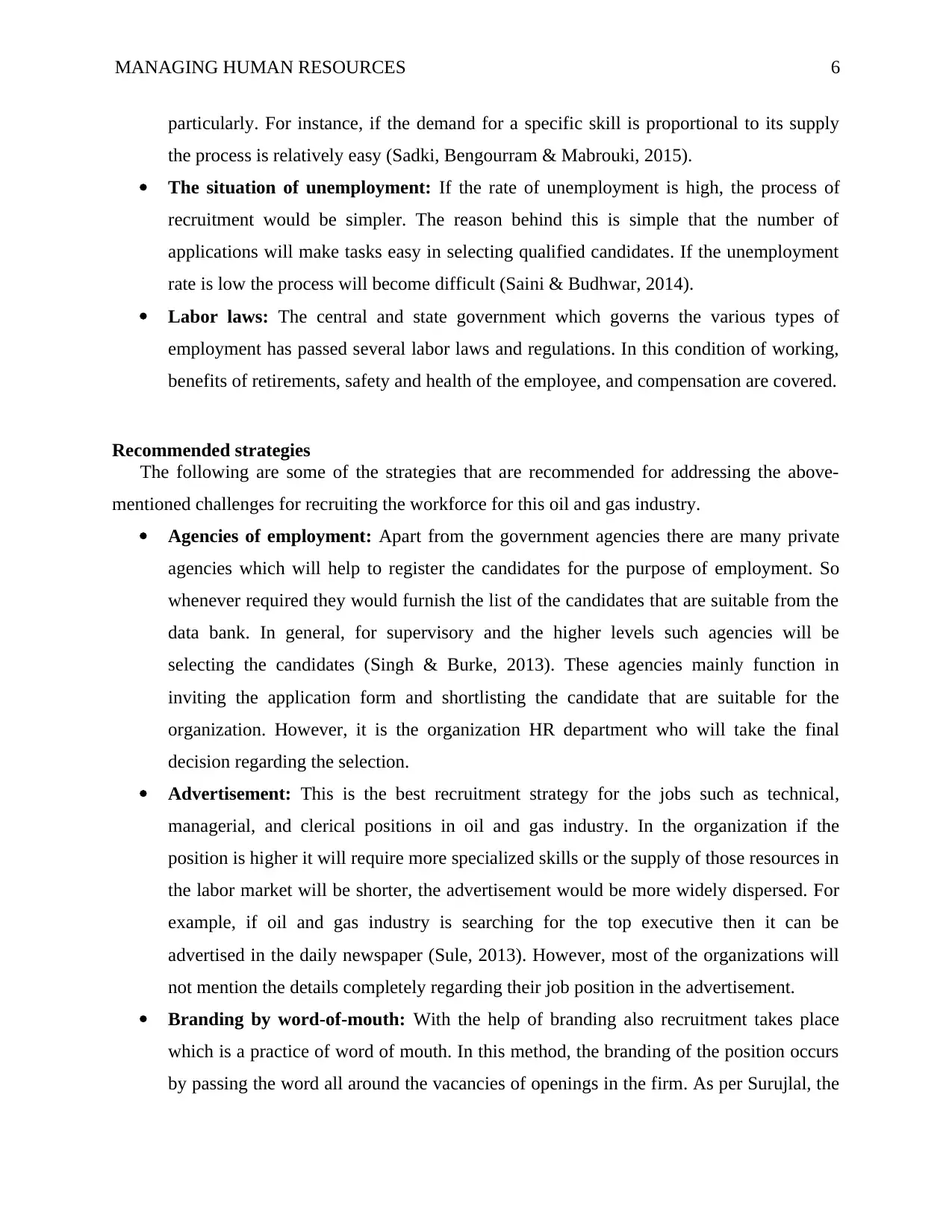
MANAGING HUMAN RESOURCES 6
particularly. For instance, if the demand for a specific skill is proportional to its supply
the process is relatively easy (Sadki, Bengourram & Mabrouki, 2015).
The situation of unemployment: If the rate of unemployment is high, the process of
recruitment would be simpler. The reason behind this is simple that the number of
applications will make tasks easy in selecting qualified candidates. If the unemployment
rate is low the process will become difficult (Saini & Budhwar, 2014).
Labor laws: The central and state government which governs the various types of
employment has passed several labor laws and regulations. In this condition of working,
benefits of retirements, safety and health of the employee, and compensation are covered.
Recommended strategies
The following are some of the strategies that are recommended for addressing the above-
mentioned challenges for recruiting the workforce for this oil and gas industry.
Agencies of employment: Apart from the government agencies there are many private
agencies which will help to register the candidates for the purpose of employment. So
whenever required they would furnish the list of the candidates that are suitable from the
data bank. In general, for supervisory and the higher levels such agencies will be
selecting the candidates (Singh & Burke, 2013). These agencies mainly function in
inviting the application form and shortlisting the candidate that are suitable for the
organization. However, it is the organization HR department who will take the final
decision regarding the selection.
Advertisement: This is the best recruitment strategy for the jobs such as technical,
managerial, and clerical positions in oil and gas industry. In the organization if the
position is higher it will require more specialized skills or the supply of those resources in
the labor market will be shorter, the advertisement would be more widely dispersed. For
example, if oil and gas industry is searching for the top executive then it can be
advertised in the daily newspaper (Sule, 2013). However, most of the organizations will
not mention the details completely regarding their job position in the advertisement.
Branding by word-of-mouth: With the help of branding also recruitment takes place
which is a practice of word of mouth. In this method, the branding of the position occurs
by passing the word all around the vacancies of openings in the firm. As per Surujlal, the
particularly. For instance, if the demand for a specific skill is proportional to its supply
the process is relatively easy (Sadki, Bengourram & Mabrouki, 2015).
The situation of unemployment: If the rate of unemployment is high, the process of
recruitment would be simpler. The reason behind this is simple that the number of
applications will make tasks easy in selecting qualified candidates. If the unemployment
rate is low the process will become difficult (Saini & Budhwar, 2014).
Labor laws: The central and state government which governs the various types of
employment has passed several labor laws and regulations. In this condition of working,
benefits of retirements, safety and health of the employee, and compensation are covered.
Recommended strategies
The following are some of the strategies that are recommended for addressing the above-
mentioned challenges for recruiting the workforce for this oil and gas industry.
Agencies of employment: Apart from the government agencies there are many private
agencies which will help to register the candidates for the purpose of employment. So
whenever required they would furnish the list of the candidates that are suitable from the
data bank. In general, for supervisory and the higher levels such agencies will be
selecting the candidates (Singh & Burke, 2013). These agencies mainly function in
inviting the application form and shortlisting the candidate that are suitable for the
organization. However, it is the organization HR department who will take the final
decision regarding the selection.
Advertisement: This is the best recruitment strategy for the jobs such as technical,
managerial, and clerical positions in oil and gas industry. In the organization if the
position is higher it will require more specialized skills or the supply of those resources in
the labor market will be shorter, the advertisement would be more widely dispersed. For
example, if oil and gas industry is searching for the top executive then it can be
advertised in the daily newspaper (Sule, 2013). However, most of the organizations will
not mention the details completely regarding their job position in the advertisement.
Branding by word-of-mouth: With the help of branding also recruitment takes place
which is a practice of word of mouth. In this method, the branding of the position occurs
by passing the word all around the vacancies of openings in the firm. As per Surujlal, the
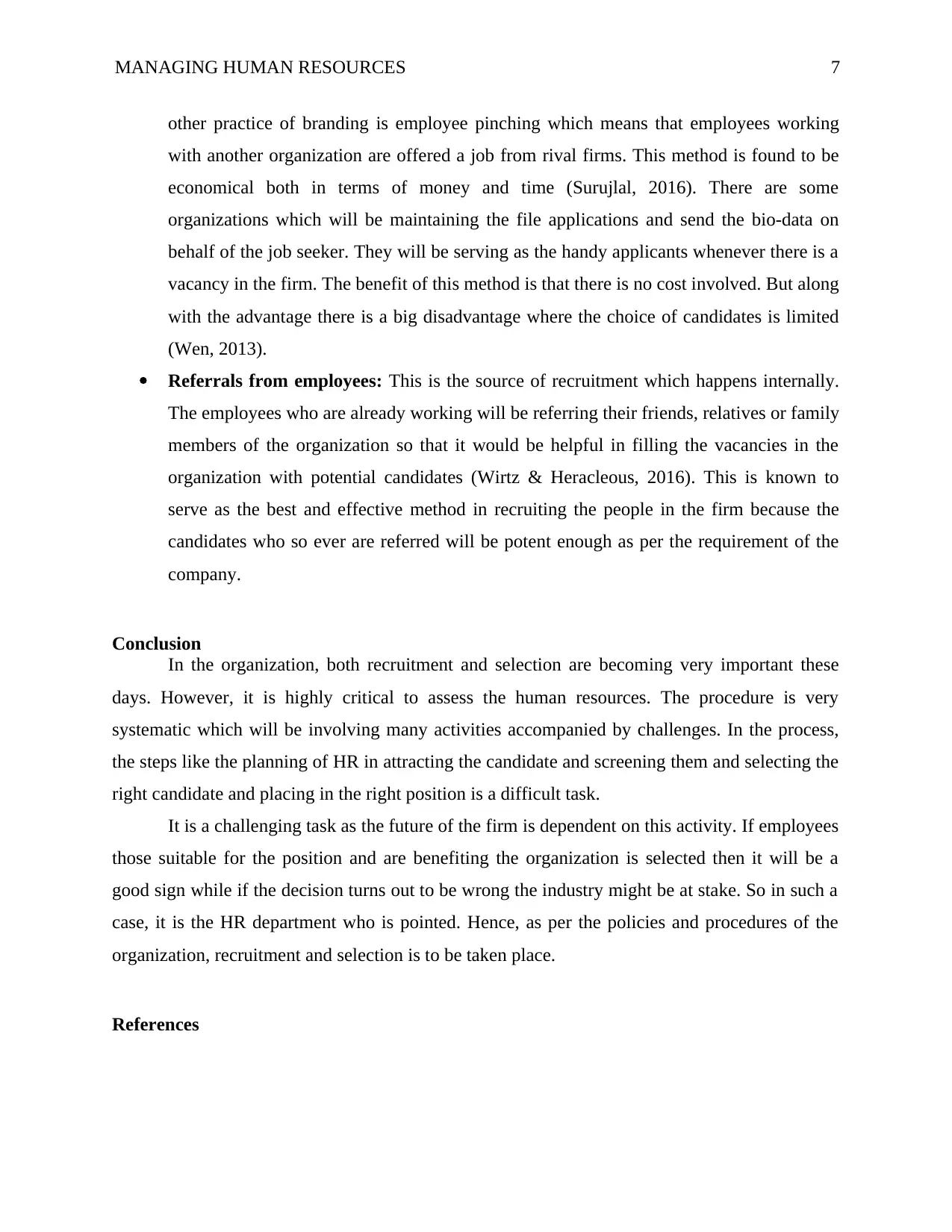
MANAGING HUMAN RESOURCES 7
other practice of branding is employee pinching which means that employees working
with another organization are offered a job from rival firms. This method is found to be
economical both in terms of money and time (Surujlal, 2016). There are some
organizations which will be maintaining the file applications and send the bio-data on
behalf of the job seeker. They will be serving as the handy applicants whenever there is a
vacancy in the firm. The benefit of this method is that there is no cost involved. But along
with the advantage there is a big disadvantage where the choice of candidates is limited
(Wen, 2013).
Referrals from employees: This is the source of recruitment which happens internally.
The employees who are already working will be referring their friends, relatives or family
members of the organization so that it would be helpful in filling the vacancies in the
organization with potential candidates (Wirtz & Heracleous, 2016). This is known to
serve as the best and effective method in recruiting the people in the firm because the
candidates who so ever are referred will be potent enough as per the requirement of the
company.
Conclusion
In the organization, both recruitment and selection are becoming very important these
days. However, it is highly critical to assess the human resources. The procedure is very
systematic which will be involving many activities accompanied by challenges. In the process,
the steps like the planning of HR in attracting the candidate and screening them and selecting the
right candidate and placing in the right position is a difficult task.
It is a challenging task as the future of the firm is dependent on this activity. If employees
those suitable for the position and are benefiting the organization is selected then it will be a
good sign while if the decision turns out to be wrong the industry might be at stake. So in such a
case, it is the HR department who is pointed. Hence, as per the policies and procedures of the
organization, recruitment and selection is to be taken place.
References
other practice of branding is employee pinching which means that employees working
with another organization are offered a job from rival firms. This method is found to be
economical both in terms of money and time (Surujlal, 2016). There are some
organizations which will be maintaining the file applications and send the bio-data on
behalf of the job seeker. They will be serving as the handy applicants whenever there is a
vacancy in the firm. The benefit of this method is that there is no cost involved. But along
with the advantage there is a big disadvantage where the choice of candidates is limited
(Wen, 2013).
Referrals from employees: This is the source of recruitment which happens internally.
The employees who are already working will be referring their friends, relatives or family
members of the organization so that it would be helpful in filling the vacancies in the
organization with potential candidates (Wirtz & Heracleous, 2016). This is known to
serve as the best and effective method in recruiting the people in the firm because the
candidates who so ever are referred will be potent enough as per the requirement of the
company.
Conclusion
In the organization, both recruitment and selection are becoming very important these
days. However, it is highly critical to assess the human resources. The procedure is very
systematic which will be involving many activities accompanied by challenges. In the process,
the steps like the planning of HR in attracting the candidate and screening them and selecting the
right candidate and placing in the right position is a difficult task.
It is a challenging task as the future of the firm is dependent on this activity. If employees
those suitable for the position and are benefiting the organization is selected then it will be a
good sign while if the decision turns out to be wrong the industry might be at stake. So in such a
case, it is the HR department who is pointed. Hence, as per the policies and procedures of the
organization, recruitment and selection is to be taken place.
References
Paraphrase This Document
Need a fresh take? Get an instant paraphrase of this document with our AI Paraphraser
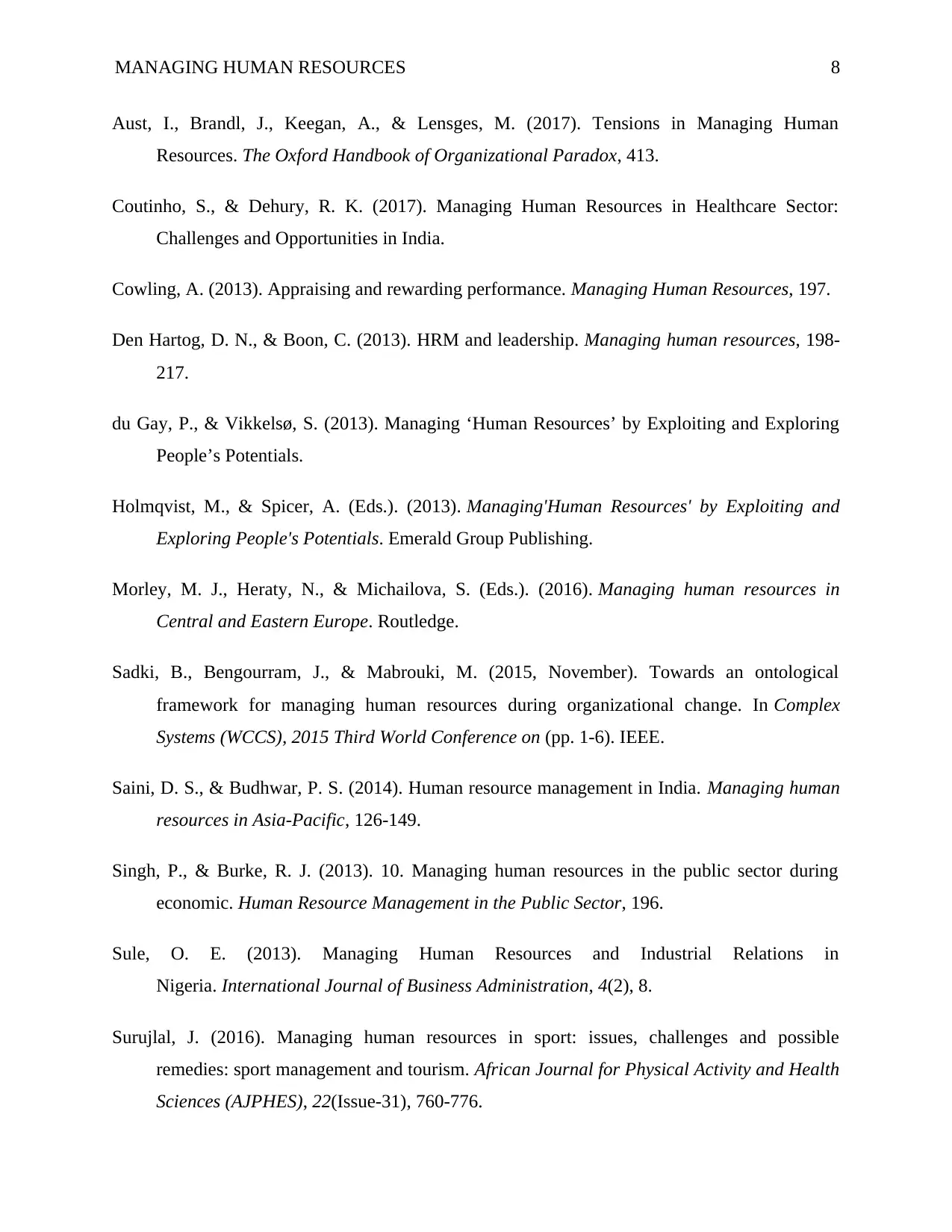
MANAGING HUMAN RESOURCES 8
Aust, I., Brandl, J., Keegan, A., & Lensges, M. (2017). Tensions in Managing Human
Resources. The Oxford Handbook of Organizational Paradox, 413.
Coutinho, S., & Dehury, R. K. (2017). Managing Human Resources in Healthcare Sector:
Challenges and Opportunities in India.
Cowling, A. (2013). Appraising and rewarding performance. Managing Human Resources, 197.
Den Hartog, D. N., & Boon, C. (2013). HRM and leadership. Managing human resources, 198-
217.
du Gay, P., & Vikkelsø, S. (2013). Managing ‘Human Resources’ by Exploiting and Exploring
People’s Potentials.
Holmqvist, M., & Spicer, A. (Eds.). (2013). Managing'Human Resources' by Exploiting and
Exploring People's Potentials. Emerald Group Publishing.
Morley, M. J., Heraty, N., & Michailova, S. (Eds.). (2016). Managing human resources in
Central and Eastern Europe. Routledge.
Sadki, B., Bengourram, J., & Mabrouki, M. (2015, November). Towards an ontological
framework for managing human resources during organizational change. In Complex
Systems (WCCS), 2015 Third World Conference on (pp. 1-6). IEEE.
Saini, D. S., & Budhwar, P. S. (2014). Human resource management in India. Managing human
resources in Asia-Pacific, 126-149.
Singh, P., & Burke, R. J. (2013). 10. Managing human resources in the public sector during
economic. Human Resource Management in the Public Sector, 196.
Sule, O. E. (2013). Managing Human Resources and Industrial Relations in
Nigeria. International Journal of Business Administration, 4(2), 8.
Surujlal, J. (2016). Managing human resources in sport: issues, challenges and possible
remedies: sport management and tourism. African Journal for Physical Activity and Health
Sciences (AJPHES), 22(Issue-31), 760-776.
Aust, I., Brandl, J., Keegan, A., & Lensges, M. (2017). Tensions in Managing Human
Resources. The Oxford Handbook of Organizational Paradox, 413.
Coutinho, S., & Dehury, R. K. (2017). Managing Human Resources in Healthcare Sector:
Challenges and Opportunities in India.
Cowling, A. (2013). Appraising and rewarding performance. Managing Human Resources, 197.
Den Hartog, D. N., & Boon, C. (2013). HRM and leadership. Managing human resources, 198-
217.
du Gay, P., & Vikkelsø, S. (2013). Managing ‘Human Resources’ by Exploiting and Exploring
People’s Potentials.
Holmqvist, M., & Spicer, A. (Eds.). (2013). Managing'Human Resources' by Exploiting and
Exploring People's Potentials. Emerald Group Publishing.
Morley, M. J., Heraty, N., & Michailova, S. (Eds.). (2016). Managing human resources in
Central and Eastern Europe. Routledge.
Sadki, B., Bengourram, J., & Mabrouki, M. (2015, November). Towards an ontological
framework for managing human resources during organizational change. In Complex
Systems (WCCS), 2015 Third World Conference on (pp. 1-6). IEEE.
Saini, D. S., & Budhwar, P. S. (2014). Human resource management in India. Managing human
resources in Asia-Pacific, 126-149.
Singh, P., & Burke, R. J. (2013). 10. Managing human resources in the public sector during
economic. Human Resource Management in the Public Sector, 196.
Sule, O. E. (2013). Managing Human Resources and Industrial Relations in
Nigeria. International Journal of Business Administration, 4(2), 8.
Surujlal, J. (2016). Managing human resources in sport: issues, challenges and possible
remedies: sport management and tourism. African Journal for Physical Activity and Health
Sciences (AJPHES), 22(Issue-31), 760-776.
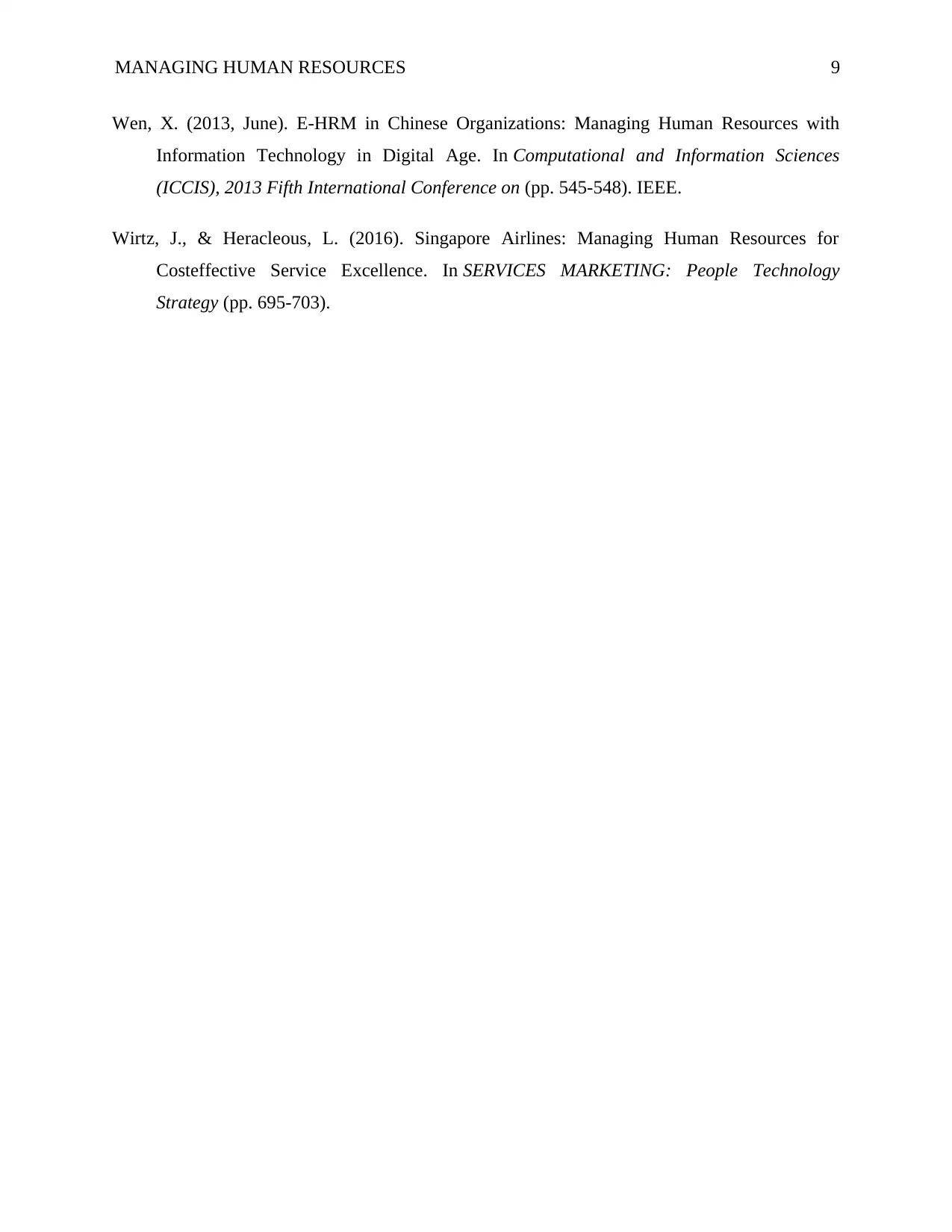
MANAGING HUMAN RESOURCES 9
Wen, X. (2013, June). E-HRM in Chinese Organizations: Managing Human Resources with
Information Technology in Digital Age. In Computational and Information Sciences
(ICCIS), 2013 Fifth International Conference on (pp. 545-548). IEEE.
Wirtz, J., & Heracleous, L. (2016). Singapore Airlines: Managing Human Resources for
Costeffective Service Excellence. In SERVICES MARKETING: People Technology
Strategy (pp. 695-703).
Wen, X. (2013, June). E-HRM in Chinese Organizations: Managing Human Resources with
Information Technology in Digital Age. In Computational and Information Sciences
(ICCIS), 2013 Fifth International Conference on (pp. 545-548). IEEE.
Wirtz, J., & Heracleous, L. (2016). Singapore Airlines: Managing Human Resources for
Costeffective Service Excellence. In SERVICES MARKETING: People Technology
Strategy (pp. 695-703).
1 out of 9
Related Documents
Your All-in-One AI-Powered Toolkit for Academic Success.
+13062052269
info@desklib.com
Available 24*7 on WhatsApp / Email
![[object Object]](/_next/static/media/star-bottom.7253800d.svg)
Unlock your academic potential
© 2024 | Zucol Services PVT LTD | All rights reserved.





